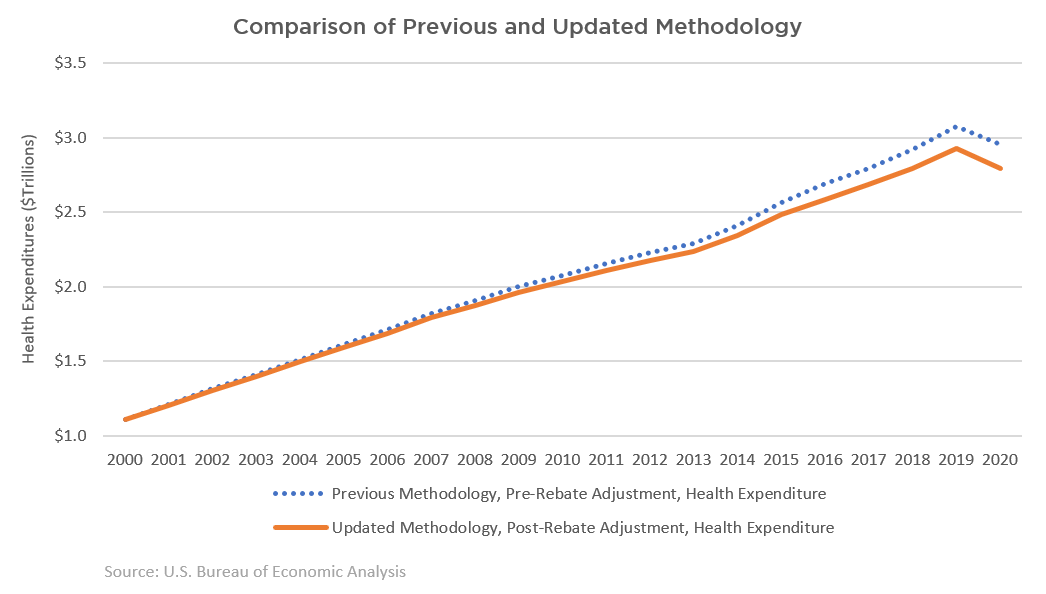The Bureau of Economic Analysis today updated its supplemental health care statistics with an improved methodology that shows the growing role of prescription drug rebates over two decades. After subtracting the rebates, BEA's estimate of health care spending in 2020 was reduced by $158 billion, or 5.3 percent, from the previous estimate for 2020.
The Health Care Satellite Account measures spending on treatment of medical conditions, such as cancer or diabetes. This more-detailed, disease-centered view supplements BEA's traditional economic statistics for a deeper understanding of health care spending patterns and policies.
Manufacturer rebates are discounts provided by drugmakers to intermediary companies, called pharmacy benefit managers, after drugs are dispensed. Rebate negotiations are confidential, which has prevented researchers from estimating the magnitude of the discounts. BEA's new methodology uses drug price data from a private data aggregator, SSR Health LLC's US Brand Rx Net Pricing Tool, to estimate manufacturer rebates
BEA mapped the SSR Health data to pharmaceutical claims and subtracted drug-specific rebates from prescription spending. The improved methodology reduced the estimate of health care expenditure in 2020 to nearly $2.80 trillion, from more than $2.95 trillion in the Health Care Satellite Account data released in February.
The comparison between methodologies shows the growing importance of rebates over two decades. Rebates were issued for more than 5 percent of overall health spending in 2020, according to the new estimates.
At the disease level, the impact of manufacturer rebates is most noticeable among endocrine, infectious, and circulatory conditions.
The ranking of the five categories with the highest expenditures in 2020 was unchanged. Neoplasms, including cancers, moved up from the disease with the eighth-highest spending to sixth place when manufacturer rebates were subtracted.
| Diseases | Previous Methodology, Pre-Rebate Adjustment, Current Expenditure (2020) | Updated Methodology, Post-Rebate Adjustment, Current Expenditure (2020) | Difference Attributed to Rebates |
| $ Billions | |||
| Symptoms; signs; and ill-defined conditions | 350.73 | 336.23 | 14.50 |
| Diseases of the circulatory system | 265.67 | 248.47 | 17.20 |
| Diseases of the musculoskeletal system and connective tissue | 227.03 | 217.23 | 9.80 |
| Infectious and parasitic diseases | 222.85 | 205.12 | 17.73 |
| Diseases of the nervous system and sense organs | 188.65 | 177.09 | 11.56 |
| Neoplasms | 165.09 | 161.71 | 3.38 |
| Diseases of the respiratory system | 165.21 | 149.17 | 16.04 |
| Endocrine; nutritional; and metabolic diseases and immunity disorders | 185.45 | 146.85 | 38.60 |
| Injury and poisoning | 135.52 | 132.92 | 2.60 |
| Mental illness | 136.14 | 128.79 | 7.35 |
| Diseases of the digestive system | 128.40 | 125.02 | 3.38 |
| Diseases of the genitourinary system | 121.40 | 115.48 | 5.92 |
| Diseases of the skin and subcutaneous organs | 62.96 | 58.25 | 4.71 |
| Complications of pregnancy; childbirth; and the puerperium | 50.46 | 51.25 | (0.79) |
| Residual codes; unclassified; all E codes | 53.85 | 48.52 | 5.33 |
| Diseases of the blood and blood-forming organs | 26.71 | 25.48 | 1.23 |
| Certain conditions originating in the perinatal period | 12.20 | 12.45 | (0.25) |
| Congenital anomalies | 7.99 | 7.89 | 0.10 |
As in the health care data released in February, the updated methodology continues to show spending decreased for 15 of the account's 18 major disease categories in 2020, likely reflecting temporary closures of non-emergency health care settings because of the COVID-19 pandemic and an increase in patients postponing non-emergency care.
In the updated data, spending on infectious and parasitic diseases amounted to more than $205 billion in 2020, the first year of the pandemic. That was an increase of $78 billion over 2019.
Find the newly released health care statistics online at bea.gov. The health statistics released in February are archived.
For more about using SSR Health data to understand manufacturer rebates, see the National Bureau of Economic Research working paper, "Rebates in the Pharmaceutical Industry: Evidence From Medicines Sold in Retail Pharmacies in the U.S," March 2020.

